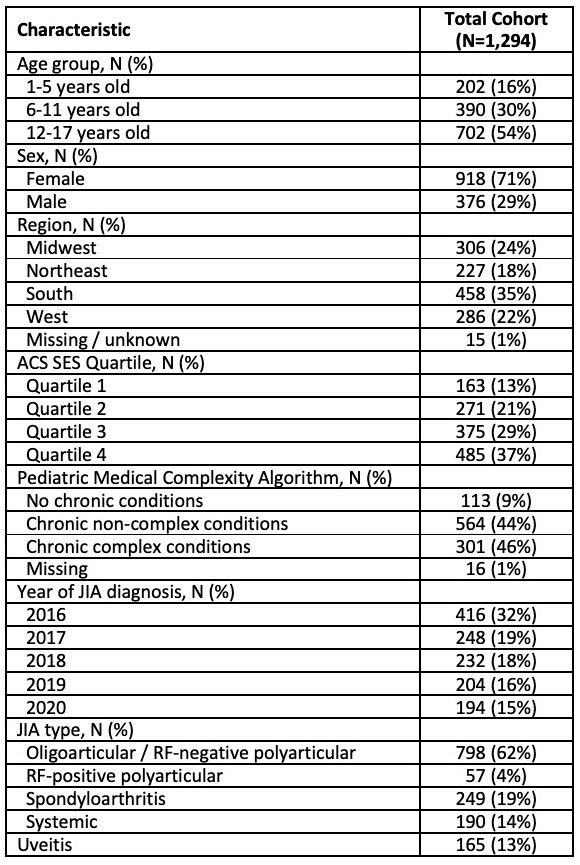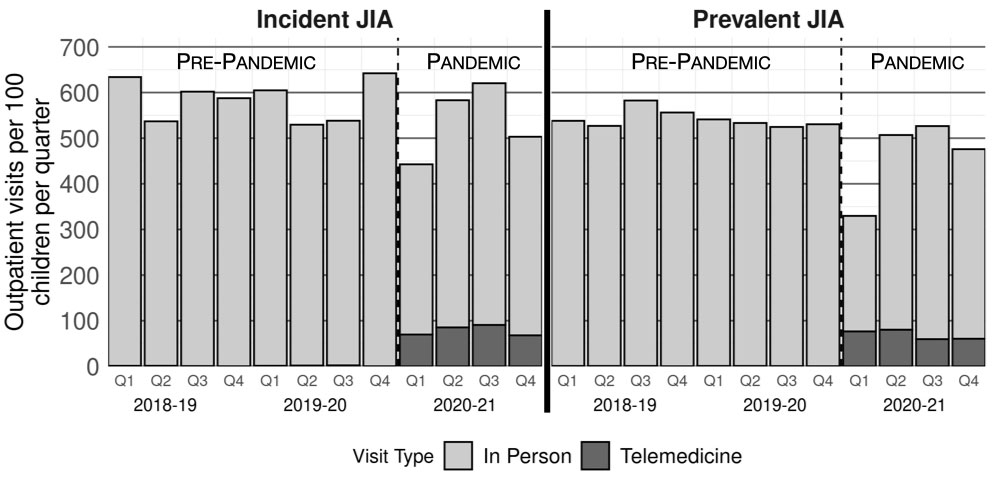Session Information
Session Type: Poster Session B
Session Time: 9:00AM-10:30AM
Background/Purpose: Limited information exists on COVID-19 pandemic-related changes in the management of rheumatic diseases in adults or children, besides what patients and families have reported. We studied healthcare and treatment utilization among commercially insured children with JIA over the first year of the US pandemic.
Methods: Using commercial health plan data (2016-2021), we identified children diagnosed with JIA before age 18 based on ICD-10 codes and previously used algorithms. Anchored on 01Mar2020, we studied quarters (Q1 started in March) in 2018-21 to determine rates of outpatient visits, new DMARD initiations, intra-articular glucocorticoid injections (iaGC), and dispensed oral glucocorticoids and opioids. Quarterly rates were expressed as means per 100 subjects with 95% confidence intervals (CIs). Incident rate ratios (IRR, pandemic vs. pre-pandemic) with 95% CIs were estimated using Poisson or Quasi-Poisson models (based on dispersion parameters) adjusted for calendar time, quarter, age group, sex, region, census tract-based socioeconomic status (visit outcome only), medical complexity (Pediatric Medical Complexity Algorithm) (visit outcome only), JIA type (systemic JIA vs. other), and stratified by diagnosis recency (incident JIA, < 12 months ago; prevalent JIA, ≥12 months ago).
Results: Overall, 1,294 children diagnosed with JIA were followed for median 21 months (interquartile range 15, 27) (Table 1). Fewer total and in-person outpatient visits for JIA occurred in Q1 2020 compared to Q1 2018-2019 (Figure). Telemedicine visits occurred at higher rates throughout the pandemic period compared to the pre-pandemic period, but relative use of telemedicine dropped from 21% of visits in Q1 to 13% of visits by Q4 (Figure). The overall rate of quarterly outpatient visits for JIA during the pandemic was about 10% lower for those with incident JIA and 12% lower for those with prevalent JIA (Table 2). Compared to prior years, overall rates of new DMARD initiations during the pandemic were modestly lower among those with incident JIA (IRR 0.71 (95% CI 0.33, 1.54)), while rates of iaGC were lower among those with prevalent JIA (IRR 0.60 (95% CI 0.34, 1.07)), albeit with limited precision. During the pandemic, oral glucocorticoids and opioids were dispensed at higher rates to those with incident JIA than to those with prevalent JIA. Among those with prevalent JIA, overall rates of oral glucocorticoid and opioid dispensing during the pandemic were >50% lower versus prior years (Table 2). In contrast, glucocorticoid and opioid dispensing for children with incident JIA was not substantively different during the pandemic compared with prior years (Table 2).
Conclusion: In the first year of the pandemic, visits for JIA dropped by 10-12% in commercially insured children in the US, declines partly mitigated by use of telemedicine. Pandemic-related declines in acute treatments for JIA and pain were observed for children with prevalent, but not incident, JIA. These changes may have important implications for disease control, quality of life, and risk of COVID-19 and underscore the value of tracking the impact of health care system disruptions on vulnerable populations such as children with JIA.
ACS SES, American Community Survey socioeconomic status; RF, rheumatoid factor
Crude quarterly rates of outpatient in-person (light grey) and telemedicine (dark grey) visits for JIA per 100 children pre-pandemic (Mar 2018-Feb 2020) and during the pandemic (Mar 2020-Feb 2021). Pre-pandemic and pandemic periods are shown separated by a vertical dashed line. Incident JIA was diagnosed within the prior 12 months. Prevalent JIA was diagnosed at least 12 months prior.
CI, confidence interval; DMARD, disease-modifying antirheumatic drug; iaGC, intra-articular glucocorticoid injection; IRR, incident rate ratio; JIA, juvenile idiopathic arthritis.
Crude rates of study outcomes are presented per 100 subjects per quarter in pre-pandemic (Mar 2018-Feb 2020) and pandemic (Mar 2020-Feb 2021) periods. Incidence rate ratios (95% confidence intervals) were produced by Poisson or Quasi-Poisson modeling (based on dispersion parameters) adjusted for calendar time, quarter, age group, sex, region, census tract-based socioeconomic status quartile (visit outcome only), medical complexity (Pediatric Medical Complexity Algorithm) (visit outcome only), JIA type (systemic JIA vs. other), and stratified by diagnosis recency (incident JIA, <12 months ago; prevalent JIA, ≥12 months ago).
To cite this abstract in AMA style:
Horton D, Yang Y, Neikirk A, Huang C, Crystal S, davidow a, Haynes K, Gerhard T, Rose C, Strom B, Parlett L. Impact of the COVID-19 Pandemic on the Management of Juvenile Idiopathic Arthritis: An Analysis of National United States Administrative Claims Data [abstract]. Arthritis Rheumatol. 2022; 74 (suppl 9). https://acrabstracts.org/abstract/impact-of-the-covid-19-pandemic-on-the-management-of-juvenile-idiopathic-arthritis-an-analysis-of-national-united-states-administrative-claims-data/. Accessed .« Back to ACR Convergence 2022
ACR Meeting Abstracts - https://acrabstracts.org/abstract/impact-of-the-covid-19-pandemic-on-the-management-of-juvenile-idiopathic-arthritis-an-analysis-of-national-united-states-administrative-claims-data/



